When I was a child some of my favourite stories were about the great Australian grain races, and the Tea Clippers sailing across the oceans from China. The photographs and drawings of these huge sailing ships fascinated me, and no doubt countless others, because today, ‘Tall Ships’, as they are now called, draw enthusiastic crowds in much the same way that steam trains do. People nowadays put this crowd pulling down to nostalgia, but even in their heyday these massive sailing ships with their graceful lines and billowing sails drew even bigger crowds, and many had songs and stories woven around their legendary voyages.
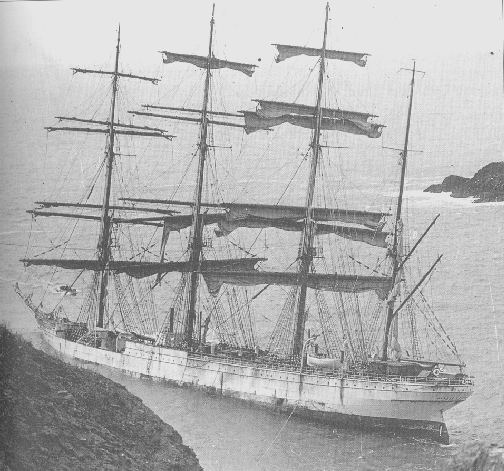
Probably the very last of these ships to be wrecked on the south coast of England was the Herzogin Cecilie, or as she was more affectionately known, the Duchess. She was a four masted steel barque built by Rickmers of Bremerhaven in 1902 as a school ship for the North German Lloyd Line, and was 314 feet long with a gross tonnage of 3242 tons. When the Great War started the Herzogin Cecilie was interned in Chile for the duration, and afterwards she was allocated to France by the War Reparations Board. The Germans tried to repurchase her but were turned down flat, and eventually she passed into Finnish ownership, being bought and commanded by Captain Gustaf Erickson of Mariehamn. Under his ownership the Herzogin Cecilie carried cargo’s all over the world, but it was the Australian Grain Races that made her famous, winning eight of them in succession.
In 1936 the ‘Duchess’ started what was to be her last voyage and her last Grain Race. From Port Lincon in Australia to Falmouth took her just 86 days, comfortable beating her nearest rival, the Pommern, by seven whole days. Her orders at Falmouth were to proceed to Ipswich to discharge her cargo of grain, but two days later, early on the morning of the 25 January, in thick fog and rough seas the Herzogin Cecilie struck the Hamstone just a few miles from Salcombe. Holed in the forpeak, the ship pounded fiercely then settled by her head with her well decks awash.
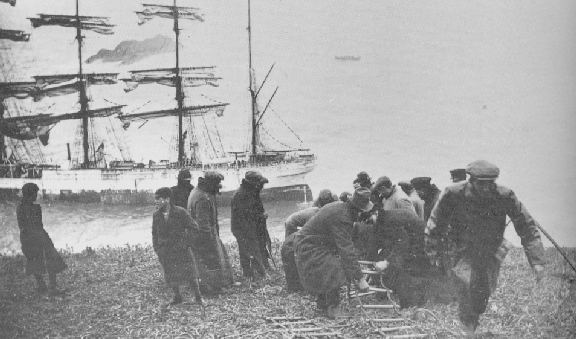
When dawn broke just about everybody and his aunt had turned up to view the wreck, and quite a lot thought that they should also go on board. This considerable hampered the rescue operation, but in the end the Salcombe lifeboat took off twenty-two of the crew, leaving just the Captain, his wife, and six crewmembers. A breeches buoy was rigged up to take off all the luggage and personal belongings, but most of this was quickly stolen when it landed by members of the public, who had by now degenerated into something of a mob.
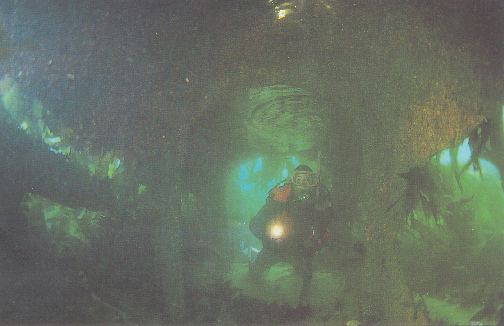
For seven weeks the Herzogin Cecilie lay stranded on the Hamstone whilst her four and a half thousand tons of grain rotted and fermented. The stench was appalling and fears of it polluting the beaches around Salcombe kept the owner and the local council arguing fit to bust. Every day huge crowds gathered to view the ‘Duchess’ and local farmers made a fortune charging people to cross their land for a better look. Eventually the grain became so swollen that it started to crack the decks, and this seemed to galvanise the salvage attempts. By 7 June enough of her rotting cargo had been removed to allow the installation of powerful pumps, and on each high tide tugs repeatedly attempted to pull her off. At first it looked as if the ‘Duchess’ was stuck fast, but finally, on 19 June the Herzogin Cecilie floated clear of the Hamstone. The local council still would not let her be towed into Salcombe, fearing all manner of disease, so in the end the ‘Duchess’ was beached in Starhole Bay just at the entrance to the harbour. Unfortunately what appeared to be a ‘safe’ sandy bottom, concealed rocks, and in the July gales she broke her back and her masts soon tumbled down into the sea. It was the beginning of the end. Ironically, if the Salcombe authorities had allowed her into harbour she would have been saved unloaded and on her way long before the gales came. As it was the thing that the council feared most happened. The grain washed out of the wreck and fetched up on all the beaches. However it didn’t cause any pollution because the seagulls eat most of it, and the rest got washed away. So much for the experts.
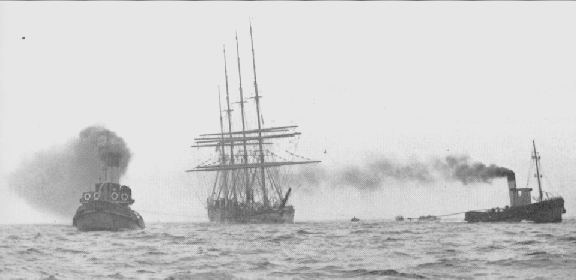
In the ensuing months all the fittings were stripped from the wreck, the beautiful figurehead sent to a museum in Finland, and the remains sold to a local scrap merchant for the princely sum of £225. A sorry end for a marvellous ship.
Today at low tide, the remains of the ‘Duchess’ just about show. In the summer there is always a buoy attached to the wreck, (at the bows) and it is prominently marked on all the carts, so you really cannot miss it. Still if you do, just ask. Everybody knows about her, and most will be glad to point her out. The wreckage lies in less than 25 feet of water on a sandy bottom, and I had been told that there was just a jumble of iron plates, and that the wreck was hardly worth diving on. Not so. The Herzogin Cecilie must be one of the prettiest wreck sites going. Part of the bows is angled over to form a sort of cave into which you can easily swim to play with the many wrasse that lurk there. Stray light twinkles in from various small jagged holes backlighting the interior with a soft glow. Marvellous for underwater photography. There is a huge amount of iron plating and decking lying across the sand and also pushed down into the sand. There is still quite a lot of material from which the sails were made buried in the sand, but what I really like about this wreck are the tunnels. Various parts of the deck and hull have fallen down in such a way as to make iron tunnels along the sand. They are not really that long and you can usually see to the end, but they are a bit special. In the tunnels, the seaweed catches the light and the current as it wafts in and out of the ragged openings, along with a myriad of small fish. It really is most enjoyable, and on one dive we all spent at least twenty minutes just swimming in and out of these tunnels. The rest of the wreck stretches out along the bay, and it is still possible to find wooden decking, and the iron pulleys that once held the ropes that hoisted up the great sails.
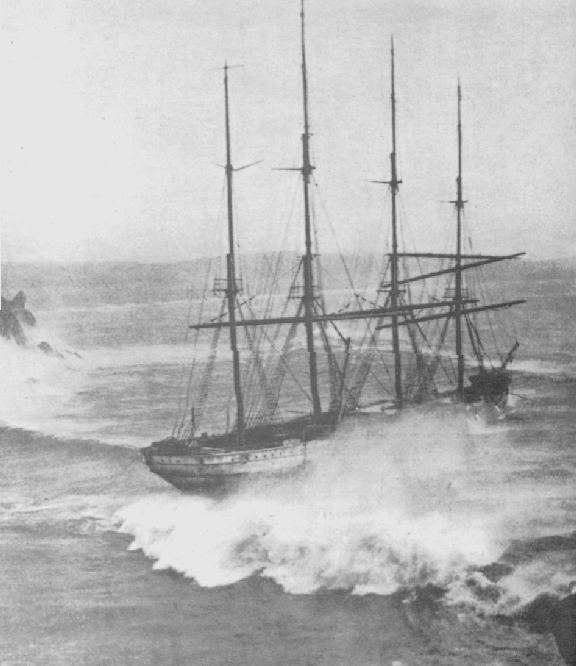
It’s a great jigsaw of a wreck, and you can either put it together, or just poke and prod about. The Herzogin Cecilie will always be remembered as one of the great square riggers, but it is as a wreck that she really lives up to her old nickname, the ‘Duchess’ a real charmer.
This book tells you all about the wreck – click the cover to learn more


Stacey Leech says
My great grandfather sailed on this ship when she left from France to come to Port Lincoln at one stage. He jumped ship here in South Australia when he was just 19 in 1925. It’s nice to find out about the end of such a life changing vessel, for without it, I may not be alive today.
Bill Peters says
I first read about Herzogin Cecille and Gustav Erickson’s fleet of square riggers in books by Alan Villers. This was in 1947 while I was in high school. These great ships were truely on of man’s most beautiful creations…
Thanks for sharing.
Bill Peters
Richard young says
I have photographs of the ship taken by my father from the cliffs above the wreck
Such a sad end to one of man’s most beautiful creations.
Richard Hodder says
My father and all his family are/were Salcombe people. I remember seeing the wreck from above many years ago.
In A J Villiers book ‘Sea Dogs of Today’ (George G Harrap and Co,London 1932) in chapter 12, Women in Windjammers, he talks about the girl stowaway Jeanne Day from Australia who left the ship at Falmouth (1928) and was last thought to be in London.She very much wanted to go to sea and was apparently a good sailor. Does anybody have any idea what happened to her?
Jackie Tanswell says
I’ve just found a couple of photographs in my late father’s album dated 1936 of this beached ship with a sort of rope bridge across to it from the land. My father is halfway across! I wondered what it was all about and googled it. What a fascinating story!
paul de- says
My Father was up in the Coastguard hut with one of the duty coast guards, a Mr Ripley, on the morning that she had struck the rocks. He managed to get some photographs, but in a very short time there were ‘crowds’ apparently.
My Grandad used to tell me how they went round there to fix a Breeches to take off the crew that had stayed aboard; he also used to tell of the foul smell from the grains.
Submerged Comment says
Britt Gow (Brittgow@gmail.com0 wrote:
Thank you for writing about this wreck – my grandfather, Sven Eriksson, was the captain. I grew up learning about the family heritage of the Herzogin Cecile and how my grandparents met, married and conceived my father on board! The captains cabinis now at the Mariehamn Museum, Aland, Finland.
Perhaps one day I will learn to dive and travel to this site to see the wonderful tunnels of seaweed.
Christina Tooley (Nee Day) says
Response to Richard Hodder about the girl stowaway, Jeanne Day. What happened to her? She lived in London for a couple of years, then gave birth to a son (out of wedlock – shocking!) who became my father, name of Peter Day. She lived a long life here in the UK, had another son who sadly drowned in his teens. My father married my mother and had my older brother and myself, then when they divorced remarried and had another two children. Jeanne died a few years ago.
David Wines says
In 1965 while working at Hope Cove I got to meet local fisherman Jack Jarvis. At first light one morning I was lucky enough to go out in his boat to help him lift his pots. As we approached Sewer (now Soar) Mill Cove, he recounted how while out fishing in the grey misty light of dawn on April 25 1936 he had been suddenely confronted by the amazing sight of this magnificent four masted ship aground. It was a tragedy that after so much hard work to save her she ended up wrecked in Starhole Bay.
Jay says
Re Jeanne Day – Dear Christina Tooley, Did your grandmother ever write an account of her time on Herzogin Cecilie?? Had she sailed before she stowed away? What a woman. Brilliant story.
David Brown says
I have memories of “the Duchess” from swimming and fishing around her in the ’50s. I think most locals knew the story – almost certainly her compasses were affected by the iron ore in Bolt Head as were those of earlier vessels. David Wines; swimming at Millbay?
Dennis Driscoll says
Re Jeanne Day. When a young boy I read Villiers account of the stowaway and marveled at her courage. I often wondered what happened to her in England. I found a news paper cutting that said that she attempted to return to sea as crew but found no berth. She then went to St Ives …. as a scullery maid … and there the trail went cold. So 40 years later I find the posts by Richard Hodder and Christina Touley and my curiosity has been satisfied. Thank you Christina, good to hear that Jeanne had a long life. I hope you inherited her spirit of adventure.
Keith Griffiths says
I’ve read two books about the Duchess, even built two models, must have been a wonderful sight in a wind
Paula Yliniemi says
My grandfather was sailing on this great ship. I have now read a great stories about Duchess. We have also a big painting about Hezogin Cecilie. It belongs to my grandfather. It has been in my parents home. I havent realise how famous Duchess is. This is very intersting world.
lampe ponce carlos enrique says
My grandfather was sailor students in 1911 at 1914, in the first world war as German ship, Heinrich Hermann Lampe. Arrived 25 July 1914 at the port of Coquimbo. After in 1920 will be France ship. This is a beatifull history for all the sailor and yours family.
Gösta Knochenhauer says
I noticed too late that I had misspelt my email address. The correct one is below.
Gösta knochenhauer
Kate Lance says
To Christina Tooley: I’ve only just seen this column. I wrote a biography of Alan Villiers published in 2009, see http://seabooks.net/alanvilliers.php . I read all his original diaries about the passage with Jeanne – he was a repressed young man and unkind to her, but looking beyond his words I liked her very much. I always wondered what had happened to her, so thank you so much for this information!
I’m glad she had a long life, if tragic at times. There’s a single letter from ‘Jeanne’ in Villiers’ papers that mentions ‘Peter,’ sent from 47 Tankerville Rd Streatham. I was never able to be sure it came from Jeanne Day – but if your father was Peter Day that makes it more plausible. Please feel free to contact me via seabooks.net – I’d love to know more about Jeanne. Regards, Kate
Colin Lodge says
When I was six in 1955 my family stayed in Salcombe and I remember my father taking us to the cliff above where the ‘Duchess’ struck to find the wreck that he and my mother had seen, presumably in 1936 , when they visit the area in their courting days. of course it was not to be found and dad obviously hadn’t discovered the full story of her fate. Tomorrow I am dancing with Dartington Morris Men at Salcombe Regatta and this prompted me to google the wreck. I have now laid the memory to rest and found a fascinating story. Maybe one day I will get to dive the wreck in its present position!
Julie ordan says
I have today, in a charity shop in Swaffham, Norfolk, bought for the sum of £2 an oblong piece of worked wood with an integral Rotherham thermometer measured in Fahrenheit, British patent no ? 2 or 3 78314. The inscription is , on the left of the dial, EX HERZOGIN CECILIE. To the right, WRECKED 25th APRIL 1936 BOLT HEAD DEVON. Julie.
Peter Simpson says
Re: Jeanne Day:
I have seen various hints that she wrote something about her voyage, perhaps entitled “[The]Log of a Happy Girl”…see reference 10, here:
http://www.bruzelius.info/Nautica/Ships/Fourmast_ships/Herzogin_Cecilie(1902).html
John Osthoff says
My great grandfather took my father on board herzogin cecilie in about 1930 when she was in dock at Birkenhead. A sign on the gangplank said beware of the dog, to keep strangers away!
Erin Conner says
Dear Christina Tooley,
Hello,
I’m working on a program about women sail trainees in the Twenties and Thirties. Jeanne Day is particularly interesting to me because she appears to be the first, and because she wrote up her own story. The National Library of Australia was kind enough to supply me with a copy of the magazine article she wrote. How courageous, and how inventive she was, from that account! There were other women who also got to sea, only a few years after her. How sad that none of them ever met! According to the newspaper articles I’ve been able to locate, she tried for over a year to get a berth as a sailor. In 1933, Annette Brock Davis was able to do so, having more resources than Jeanne did. They probably even visited the same London shipowners. Her book, _My Year Before The Mast_, is a real window on that time period and gave me an appreciation of how hard that task was, back then. I’d really, really like to find a copy of her book, _Log of a Happy Girl_, if it still exists. Being her descendant, do you know anything about it? Her story and her voice deserve to be preserved, and I’d like to include more about her in my program.
Britt Gow says
Another book, if readers are interested, is “The Duchess” by Pamela Eriksson (née Bourne) who sailed aboard and was on her honeymoon voyage when the ship was wrecked. My father, Sven C.B. Eriksson was conceived onboard.
Tor Aulin says
My Father, Ivan Aulin from Sweden, sailed on her 1925-1926. He was 15 years old when he entered in Hamburg in 1925. He has documented the trip with an album full of photographs. Also a note book. He became very good friends with Elis Karlsson and they communicated by letters a couple of years after the trip. My Father is mentioned in some of the books published about Herzogin Cecilie.
When I was a kid, he very seldom talked about this historic adventure. From the photo album I can see that he lost a very good friend, Johnsson. The photograph shows the two holding each others shoulders, like true friends. The caption underneath says: My friend Johnsson and me the day before he fell from the rigging and died. That’s all.
Richard Foulkes says
I have just found a Photo taken by my grand father in 1936 with hand written notes of the date and the ship on the back- does anyone want me to scan it and sent it?
Maggie Tucker says
To Chris (Christina) – if you receive this, would you be so kind as to contact me, as I am one of your Australian cousins; and it would be fabulous to touch base. (Maggie)
Christina Tooley says
To all who would like more information on Jeanne Day, please feel free to email me. I do have many articles written by her, and copies of telegrams etc. From her frantic family, who had no clue as to her fate. She bribed a sailor to row her!out to the ship as she was being loaded ready for the grain race.
Giles Nicholas Clarke says
I have a beautiful ‘ship in a bottle’ model of ‘Herzogen Cecile’ here with me at home. It was made by my great grandfather who ,according to my mother, was a crewmember.
Pity I can’t attach a picture of it here as would love you to see it
Susanna Viljanen says
“The Duchess” will always fill a special space in the heart of all of us seagoing Finns. While she was not the largest Finnish windjammer (Moshulu is) nor the fastest (Parma was), The Duchess was the most famous.
One of Eriksson’s windjammers, the four-masted barque “Pommern”, has been saved for the posteriority as a museum ship, and it is the most popular tourist attraction in Mariehamn, Finland. If you ever have a chance to visit Mariehamn, it is certainly a worth of visit – the Åland Maritime Museum, where the figurehead and captain’s salon of The Duchess reside, is just next to “Pommern”.